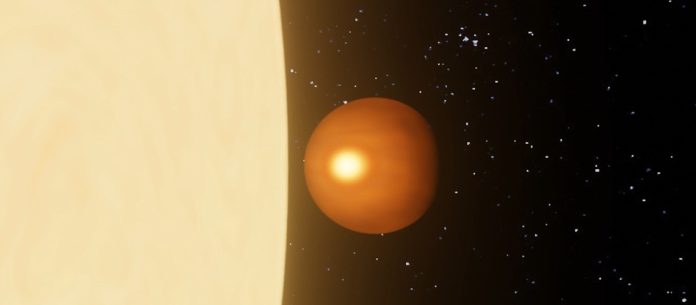
Exoplanets have been discovered with a wide range of environmental conditions. WASP-76b is one of the most extreme with a dayside temperature of over 2,000 degrees.
A team of researchers have found that it’s even more bizarre than first thought! It’s tidally locked to its host star so intense winds encircle the planet.
They contain high quantities of iron atoms that stream from the lower to upper layers around the atmosphere.
Exoplanets exist outside of our Solar System and orbit other stars. The first confirmed discovery was back in the 1990’s and since then, over 5,200 have been discovered.
Many of them are gas giants like Jupiter or Saturn and others are small rocky Earth like planets, minus perhaps their habitability status.
As more advanced telescopes and detection techniques are developed not only will our detection levels increase further but so will our ability to explore these alien worlds.
One such exoplanet, WASP-76b has received quite a lot of attention of late. It is an ultra-hot gas giant that is 640 light years from us in the direction of the constellation Pisces.
It was discovered back in 2013 and has an orbit that is very close to its host star, completing one orbit in just 1.8 Earth days!
It’s the proximity to the star that has led to the extreme daytime temperatures of over 2,000 degrees.
The intense heat is thought to vaporise iron which then condenses into liquid on the cooler night-time side and fall as iron rain!
A team of astronomers, with some from the University of Geneva, announced their findings in the journal Astronomy & Astrophysics of evidence for intense iron winds in the atmosphere of WASP-76b.
Astronomers have been focussing on this planet since its discovery to try and understand the mechanisms in the atmosphere of this ultra-hot Jupiter world.
It really is a fascinating world and even a rainbow was detected there last April!
The team kept their attention on the day-time side where the temperatures are far higher. They used the ESPRESSO spectrograph that was installed on the European Southern Observatory’s Very Large Telescope (yes that’s its name!)
It is known for its stability and high spectral resolution so it can discern wonderfully fine levels of detail in a stellar spectrum.
Using a technique known as high resolution emission spectroscopy, the team studied the visible light spectrum. The approach relies upon the detection of emission lines in a spectrum and enables the chemical composition to be decoded.
Here they detected the chemical signature of iron and found that they were moving from lower levels to the higher layers of the atmosphere.
The study of exoplanet atmospheres help us to further develop our understanding of the range of environments on these alien worlds. As a gas giant, the discoveries on WASP-76b help us learn a little more about the climates of worlds that are barraged by extreme levels of radiation from their host star.
Written by Mark Thompson/Universe Today.



